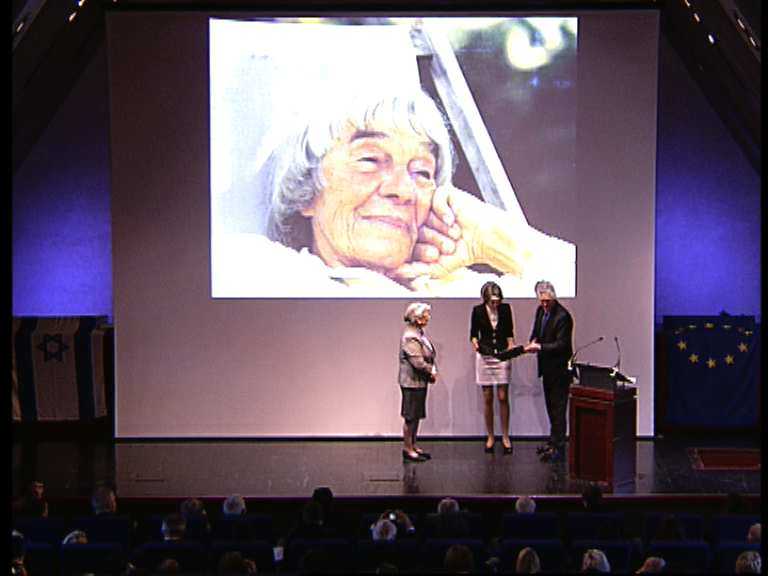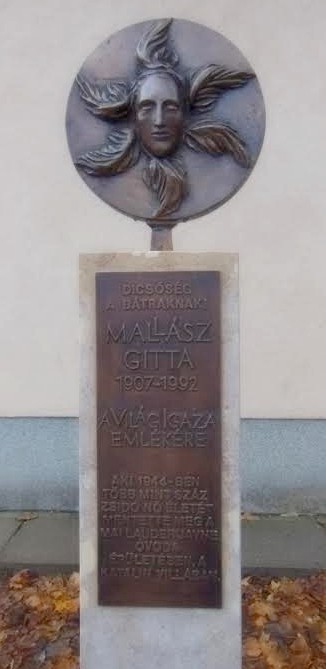On May 13, 2012, in the beautiful Bernardins convent in Paris, during a moving ceremony, Gitta Mallasz was posthumously awarded the medal of Righteous Among the Nations for having saved, in December 1944, a hundred Jewish women and children from deportation.

If Gitta Mallasz is the "scribe" who introduced the world to the Talking with Angels, account of the spiritual experience she lived in 1943-44, in Hungary, with her three friends, Joseph Kreutzer, Hanna Dallos, and Lili Strausz, she was also a courageous and daring woman who did not hesitate to risk his life to save others who were irretrievably doomed to extermination.
From June to December 1944, Gitta Malllasz was the commander of Katalin, a clothing workshop for the Hungarian army, whose workers were Jewish and which had been designed by a Catholic priest, Father Klinda, who, in Budapest occupied by the Nazis, spent himself without counting to save Jews. The factory provided good protection for its residents because, in addition to working there for the Hungarian Defence, it was placed under the protection of the nunciature and therefore benefited from extraterritoriality.
When she was asked to run "Katalin", Gitta, a general's daughter and former swimming champion, agreed on condition that Hanna and Lili were admitted. With the help of her two friends, she established order and efficiency in the workshop. The summer passed. Orders for the army were completed on time... and meetings with the angels continued in the "commander's hut". But in the autumn, the situation deteriorated: the Hungarian Nazis, even more brutal than the Germans, had come to power and were keeping an eye on this strange factory and its workers. On 5 November, they carried out their first heavy raid, but an intervention by the Nunciature saved the workers at the last minute.

In memory of Gitta Mallász
(1907-1992)
who saved the lives of more than 100 Jewish women in 1944,
in the current nursery school building,
Lauder Javne, in the Katalin villa.
At the same time, German SS men moved into the neighboring house. One day (*), a soldier, draftsman of the German armed forces, who knew Hanna at the Beaux-arts in Munich, rang the doorbell. Gitta, who speaks Goethe's language fluently, befriends him, offers to make some drawings on Hungarian folklore for his magazine, in exchange for which she receives a work certificate, with a swastika as a stamp, which which serves as an introduction to her neighbors to whom she offers to visit the factory. The Nazis take a liking to these little outings. Soon, an opening in the fence that separates the two gardens is made, to avoid them having to take a long detour through the street. And as Gitta complains about the hordes of Hungarian soldiers who come to disturb the work of her workers, promise is made to protect them: when on December 2, the Hungarian Nazis come to invade the factory, the workers will pass through the garden of the SS to blend into the nearby forest. But to Gitta's great despair, neither Hanna nor Lili will take advantage of this scheme. They allowed themselves to be arrested and deported to Ravensbrück to save Gitta from inevitable reprisals and died, in an atrocious way, in February 1945, in a cattle car (The last convoy, Eva Danos, Albin Michel, 2011).
In the 2000s, an avid reader of Talking with Angels, Monique Guillemin, undertook to obtain for Gitta the status of “Righteous Among the Nations”. She was helped by a Hungarian, Imre Boc, a former resistance fighter in Grenoble during the Second World War, who recounts the adventures that marked the constitution of the file for Yad Vashem in Risking his life. This lasted two years, from 2007 to 2009. The answer, positive, arrived on May 12, 2011.
The main witness, Susan Kis, relates in particular the fantastic spiritual atmosphere that reigned in the workshop: “We even made more shirts than what was planned, and when we had finished, we started to sing, all together! ". She also talks about the commander's cabin and how they were caught spying on what was going on there.
Returned there in 2006 with the Hungarian filmmaker Andras S Takacs,
Susan Kis recounts how she was able to flee from Katalin with her mother on December 1, 1944
Since new testimonials surfaced:
- The daughters of Ernö Erbstein, a Hungarian Jew famous for having coached the Turin football team, who stayed in Katalin with their mother. Erbstein: The triumph and tragedy of football's forgotten pioneer, By Dominic Bliss (Blizzard Books)
- That of Andreas Rusznyak who, at the age of eight, stayed in Katalin with his mother, Erszebet, who worked with Gitta Mallasz after the war.
On the other hand, the Hungarian historian Margit Beke has recently highlighted the key role of Father Klinda who imagined the legal set-up of the workshop.
Francoise Maupin
(*) Dialogues with the angel, p. 375
